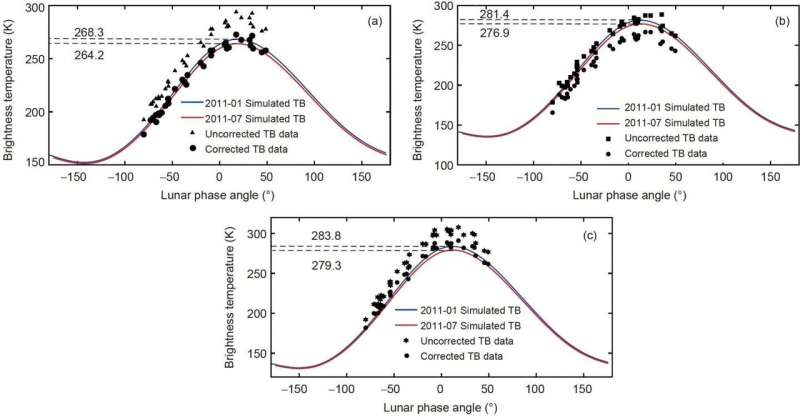The simulated temperatures are validated with the infrared TBs measured by the Diviner infrared sounder onboard the Lunar Reconnaissance Orbiter. The microwave TBs measured by China's Chang'e 2 satellite were used to invert the loss tangents of the lunar surface. The inverted loss tangents were applied to modeling the microwave TBs of lunar near side at the microwave humidity sounder's channels. The simulated average microwave TBs are consistent with the observations of the NOAA-18 microwave humidity sounder.
The analysis shows that microwave TB of the lunar surface is related to the frequency. The microwave can penetrate the lunar regolith. Microwave TB is the cumulative contribution of the regolith thermal emission. The superficial temperature plays a dominant role in microwave TB at high frequency channels because of the small penetration depth. The superficial temperature of regolith drops significantly with depth at daytime, resulting in a high microwave TB at high frequency. At night, the observed TB is low at high frequency because the superficial temperature of regolith increases with depth.
The digital counts of the microwave humidity sounder were used to fit the full width at half maxima of the sounder when the deep space view scans across the Moon. The fitted full width at half maxima was applied in deriving the average lunar TB from the observed digital counts. The simulation analysis shows that the distance between the satellite and the lunar phase angle will influence the inverted full width at half maxima. According to the study of Chang'e 2's microwave observation of the Moon, the average microwave TBs of the lunar near side at different frequencies and phase angles are modeled. The simulation can be taken as a supplemental reference for the calibration of the microwave humidity sounder onboard NOAA-18. It can be taken as the calibration source of the microwave sounders onboard geosynchronous satellites and CubeSats as well.
However, the microwave TB are measured by Chang'e 2 satellites at nadir observation. The highest frequency is 37GHz. Specific observation of lunar surface at higher frequencies and large angles are needed for improving the modeling.
Explore further



